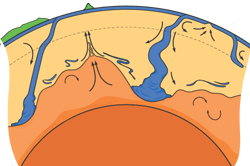What’s Down There?

Like bats using echolocation to navigate through the night, geophysicists rely on seismic waves for information on the Earth’s deep interior. Almost everything known about that inaccessible region is inferred from the speed of sound waves generated by earthquakes. In the 9 January PRL, however, a team describes a calculation of the properties of the Earth’s lower mantle starting from basic physics principles. The results disagree slightly with seismic data and suggest that the structure of minerals in the Earth’s lower mantle is more complex than geophysicists have assumed.
The Earth has an iron core surrounded by a dense layer called the mantle, which is capped with a thin rind of rocky crust. Seismic measurements reveal the density and elasticity of the mantle, but not much about its composition. Perovskite, the mineral that dominates the lower mantle, contains mainly magnesium, silicon, and oxygen, but researchers suspect that a lot of iron and aluminum are present as impurities. Exactly how much isn’t known, nor how these impurities would affect the elasticity of the rock. To further complicate the mystery, minerals often behave in unexpected ways at the extreme pressures found 1000 kilometers underground. Iron, for example, becomes non-magnetic and may tend to migrate from perovskite toward another mineral called magnesiumwustite, as the pressure rises.
To understand the mantle’s composition, geophysicists need to know the properties of rocks over a range of pressures and temperatures much wider than experimenters can measure in a lab. But so far, researchers have calculated properties for deep mantle minerals at only a few specific pressures.
Renata Wentzcovitch of the University of Minnesota in Minneapolis and her colleagues at the International School for Advanced Studies in Trieste, Italy, used computer programs they have developed over the past decade to calculate perovskite’s properties over a wide range of pressures and temperatures. They allowed the rocks to contain up to 30% of magnesiumwustite and up to 15% of iron contamination. The team solved Schrödinger’s equation–a fundamental equation of quantum mechanics–for the bond between each pair of atoms in a perovskite crystal and used the result to predict the bond strengths. They then calculated both the shear modulus and the bulk modulus, which are measures of the mineral’s ability to deform when squeezed or bent in different ways.
Researchers measuring the speed of sound through the Earth can also calculate moduli, so Wentzcovitch and her colleagues compared their own predictions for moduli with the seismic results. The calculations agreed fairly closely in the shallow mantle, but there were differences in the deep mantle. Their calculated bulk modulus was slightly higher than the seismic-derived data, and the shear modulus was slightly lower. Because the differences were not shifted in the same direction, Wentzcovitch suspects that the explanation is not simple, such as a miscalculation of the lower mantle temperature. Instead, she says it indicates that there is an important component of the rock, such as another mineral phase, that is still unknown.
Shun-ichiro Karato, of Yale University in New Haven, Connecticut, says the paper contains the “latest, most reliable” results on the properties of the lower mantle. According to Karato, the first-principles calculation of physical properties of minerals is critical in the study of the deep interior of the Earth.
–Kim Krieger
Kim Krieger is a freelance science writer in Norwalk, Connecticut.


